In early January, my mom and I spent 3 days traveling a 5 hour round trip to spend time supporting land defenders at the police blockade on the way up to Unist’ot’en Camp, where members of our neighbouring First Nation, the Wet’suwet’en, were being forcibly removed from their traditional lands by militarized RCMP in a tragic and re-traumatizing show of Canadian colonialism. It’s a long and complex story not relevant to this one, but suffice to say it kept us physically, mentally and emotionally absent from the farm that week. Which is, of course, when the drama breaks out.
We were heading home down the logging road towards the highway one night, and when we hit cell service again my phone buzzed with a note from my husband. “Chores done, Mr Chako had jumped the fence or something and was in the yard. Got him back through the gate easily enough. Falcon looks to have a cut on his belly. Though no longer bleeding. The horses had also broke through the electric fence. Gave them treats but not able to get them the other side of it and fix the fence.” When we got home, he assured me everyone was calm, moving normally, on the corect side of the perimeter fence, and had access to water and food. We thought maybe a bear had come in the barnyard? Seemed extremely unlikely as the horses have kept bears away since the summer we moved here. Maybe a particularly bad scrap between the boys? It was -20 that night, dark, and late, so I judged it okay to sleep on it, but couldn’t imagine what might have happened.
The next morning, I found the electric down and the horses milling about as Tim had described. Falcon indeed had a sickeningly deep gash on his barrel that was no longer bleeding, but Amalia had a similar, even longer injury high on her hind leg. And Firefly had blood down her leg from a small hole above a hind hock. Their blood was frozen in stalagmites down their long winter coats, but nobody was actively bleeding. The pig gates were also open.
As I looked around the barnyard and weighed all the evidence, I realized that the most likely scenario was that the boar had gotten loose and, most likely, cornered the horses in the barnyard, which they have free access to for the winter. Unless they had somehow all sliced themselves cleanly on the fence, I had to deduce that he, even with his heavy frame and short tusks, had likely lunged up and gored all three of them as they slammed up against the fences. Again, this seemed unlikely, given how docile he usually is. But – he does occasionally enjoy chasing the horses when we let him out for a romp, so this was possibly just a perfect storm – us away, him loose, horses in the far corner away from the gate, sow in heat, hormonal madness…
It was a violent and shocking scene I was imagining, but the horses were oddly calm. Worried most acutely about Falcon’s gut wound, I asked him to come into a pen on his own. He would not let me touch it, but I could see clean through to a pulsing muscle layer. I should mention now that we do not have easy access to a vet – we are 80 kilometers from the nearest clinic, and they’re small animal vets. There is no horse vet in our region, that I know of. This means calling a vet (if we can even find one that will come) is a last resort, not a first response.
My brain moved quickly – he was not bleeding anymore, he was not obviously dying, and I could not see anything that looked like organs though the hole was nearly a thumb-length deep. Most importantly, he was dead calm and asking not to be touched – and when I checked in with my awareness of him below my anxiety and worry, I knew beyond a doubt that he was okay. I took him water, hay and supplements and, after checking in again with him, left him there while leaving access open for the herd to stay close by. Here’s what the wounds looked like that morning (gore disclaimer, it’s all grisly wound pictures from here on out!):
Day 2
Active bleeding has stopped all around.
Falcon‘s gash is at least 1 inch deep and 3 inches long, and I can see the muscle underneath moving as he breathes.
Amalia‘s gash is about 6 inches long, maybe 3/4 inch deep.
Firefly has a puncture/stab wound, 1/2 inch by 1/2 inch.
Throughout the day, we watched the herd linger close to Falcon – I’d spread out hay so they wouldn’t have to leave him. The girls seemed to stay closest to him while Nechako and Spero mostly stood apart – so the three injured horses formed a little hub and the two uninjured horses contained them. There was something ceremonial about it, in the way we have seen the cows gather together silently after a big scare. While none of the horses seemed distraught or concerned, there was a palpable energy between them that seemed almost sweet – this is a herd that is tightly bonded and gets along, but not always graceful – or peaceful – about it. I wondered if, when we got through all this, their dynamic would be different.
But I digress from the blood and gore. At this point, all I had given them was oral homeopathic Arnica for trauma – I put the pellets on my hand and let them pick it off with their teeth. All three told me, otherwise, to leave them alone, not intervene, and mind my own business. This is usually their directive when it comes to tending them, but it is incredibly hard to do when there’s blood or extreme lameness! I knew I could try oil of oregano, diluted, in a spray, but I also had a jar of raw local honey – and honey is a beautiful, gentle, powerful treatment for wounds and infections. So I melted it in a water bath so as not to damage the enzymes, filled a syringe, and offered to dress the wounds. All three told me in no uncertain terms to eff off and die. So that was a no to the honey.
Interestingly, they all refesed to eat it, too. That was my next resort, to get some kind of healing substances into them internally, but only the two boys who were not injured wanted to eat the honey!
We followed up the Arnica by offering Calendula and Hypericum. The horses all picked what they wanted, and after a couple days started refusing the homeopathic remedies as well. I consulted with many of you via our Facebook page and got loads of great tips and treatments, but this time the herd sincerely wanted me to let them handle this on their own. What follows is a timeline of the wounds’ progress over a month…
Day 5
Not-great photos as it gets dark at feeding time.
Falcon has cleared all the dried and frozen blood, presumably with his own mouth as he can reach it by bending. Can still see through the layers of flesh and fat, but mostly he is excreting a yellowish goop directly on the wound. He is moving stiffly and there is swelling gathering below the wound in his belly flesh.
Amalia‘s wound continues to weep a little. The discharge at the wound is foamy. The flesh on the tail side of the wound is bunched up and I really want to find a way to smooth it out, but she would happily crush my skull before allowing that.
Firefly‘s wound appears to be healing quickly, so I don’t document.
Day 6
Falcon‘s swelling below the wound has increased. He finally lets me touch him and I am surprised to find the swelling hard; not collected fluid in the way I had imagined. He is also asking me to carefully scratch around the open flesh – healing is itchy!! His wound is knitting together from the inside out. The yellow layer is, I think, fat – and we can see it zipping shut. I worry about his flesh drying out but he shows me he can lick it – and does, regularly – to keep it moist.
Amalia must not have let me take photos this day, and Firefly was progressing normally. At this point I texted the second photo to 2 vets I have worked with before. They both said “no stitches – antibiotics if you’re worried about contamination”.With zero sign of infection (cold weather and no bugs were a huge bonus) and wounds progressing nicely, we opted to wait this one out without drugs. I concocted a spray of flax oil and essential oils to help keep bad guys away, and the horses all inhaled the oils deeply but declined the spray.
Day 8
Falcon keeps zipping himself up from the inside. That red dot in the middle is a scab – I thought it was a leaf a few days before and pulled it off without him objecting, but the next day it had reformed so, of course, I left it.
Amalia‘s wound is still oozing a foamy substance, skin still puckered, chances of doing anything about it slim-to-negative.
Day 9
Colour is extra intense from the flash
Falcon’s belly-swelling is reducing and the red scab in the middle is gone – now the fat layer is complete and all you can see when looking into the wound. Wound depth has decreased by half.
Amalia is finally forming scabs around the edges, but also still weeping the foamy substance.
Day 13
Falcon has now covered the yellow fat layer with new pink flesh and the wound is much more narrow. He continues to keep it moist and clean.
Amalia‘s wound has swollen a bit, but the foamy substance is getting more solid. Her wound is appearing more and more complex, compared to Falcon’s, which has been more straightforward in healing. Because her skin is bunched up on the left, she isn’t able to just knit the two flaps together. She’ll have to let that extra skin die and form new flesh.
Firefly‘s puncture has started to ooze the same kind of foam; I offer her a spray of healing oils; she is deeply offended.
Day 14
The horses have been galloping around and rolling in the hay, directly on their wounds.
Falcon has been especially spunky after weeks of being reserved and careful. I take this to mean he is feeling a lot better. The swelling is nearly gone.
Amalia‘s wound is covered over with hay stuck to it and my obsessive scab-picking nature wants to grab the hay when she walks by and rip it off! She knows what I’m thinking and tells me not to dare. She also indicates that when she’s ready, she can rub it off herself, taking with it the necrotic tissue I’ve been worried about. I also realize that had I been able to close the flap of skin over her wound, I might have trapped pathogens in there and complicated matters.
The herd kicking up their heels for the first time since the incident – Falcon is the one running circles around everyone else!
Day 19
Falcon is no longer moistening the wound and it has put flesh on nearly up to the height of his skin.
Amalia‘s wound has finally stopped oozing; the hay has indeed pulled off much of the necrotic skin and the exposed part now looks less like a gash that needs to heal together and more like a chunk of skin that needs to be regenerated.
Day 20
Amalia may be developing proud flesh (I have never seen it, so I can’t be sure – it looks lumpy and raised and isn’t healing very fast) but we’re not too concerned about that, since by now she’s got us well informed that we can’t do much about anything so we might as well stop worrying! Still, it would feel like more of a self-healing “victory” if she could avoid the proud flesh altogether… but that’s not what this is about (I remind myself)! I re-read Montaro’s story of directing his own healing, and of abrading his own wound to avoid proud flesh. He was able to reach his wound with his mouth – she doesn’t have that option…
Day 26
Hold the friggin phone. We’ve had 2 days of snow and extreme cold. All the horses have wandered off to dig for hay in the snow; Amalia has stayed behind and is getting a good scratch on the gate post. I wonder if… I run to grab my camera and screw on the “stalker lens” – from the back room of the house I can zoom in tight and get a better look at what she’s up to. Sure enough, she is purposefully rubbing her wound against the post! She’s abrading her own wound like Montaro did – which, we know now, is exactly the right thing to do to prevent the development of proud flesh! The video I caught is below:
And here are the wounds – Falcon’s is basically a non-issue, a little scab at this point. Amalia’s has been visibly scraped and the wound looks clean now – you can see the edges of the skin. It is no longer raised and puffy – it’s just a shallow flesh wound. This is a big difference from a week ago, when I couldn’t make heads or tails of what was happening when looking at it.

Day 30
It’s been a long month of watching and hoping I’m not a complete idiot for not intervening, but at this point it’s really amazing to see how well everything has healed.
Falcon has only a sliver of scab left, and the bare skin where the wound once was is already growing a bit of chestnut peach fuzz. In a month he’s closed and regenerated a two-inch deep gash in his belly with very little to show for it.
Amalia’s wound has taken a long time to sort itself out but is finally on the home stretch. Today she even asked me to itch the skin around it for her, something she has not trusted me to do until now. Her repair job, though in a less vital location, has been much more complex than Falcon’s but it’s amazing to see what was a mess of skin flaps, blood, foamy ooze and matted fur evolve into this little scab.
Firefly’s wound has taken just as long as the others to heal despite being so much less serious, and I wonder if actually it has had a slow time healing because it’s a puncture wound without much acess to the air. In any case, it’s also on its way.
The body is a miraculous thing. How do the cells remember the shape they their collective self should be? How do they know to make their way back to that shape, step by step? It has been hair-raising, and then humbling, to witness this process without interfering. I trust the horses to tell me what they want and need, but I want to know I left no stone unturned in case I miss something I should have done for them. As our own Mary Walby assured me in a conversation about this, observation can be action – doing nothing does not have to be neglect. I love this – counting observation as “doing”, if only to soothe our action-oriented minds. If the wounds had ever looked infected, if they were re-opening or not progressing, I may have had to “do” something. Instead, I was treated to an incredible view of what the body is designed to do – heal.
The more I listen, the less I do. The choice of the horse is paramount not only out of principle, but also because the more I let go, the more I trust their decisions, because of course they truly know better than anyone else what they need.
And meanwhile, the herd has changed. Somehow, going through this trauma and healing together has shifted their herd dynamics subtly. They seem knit together more closely; they share feed more now, they are gentler with each other. It’s kind of incredible, to see this come from a terrible incident. I’m amazed to witness all that they show me. And I’m really grateful that they’re all still thriving.
A barefoot hoof trimmer, a singer/songwriter, an amateur farmer – these are some of the hats Kesia Nagata wears when she’s not full to bursting with wondrous equine co-creation.

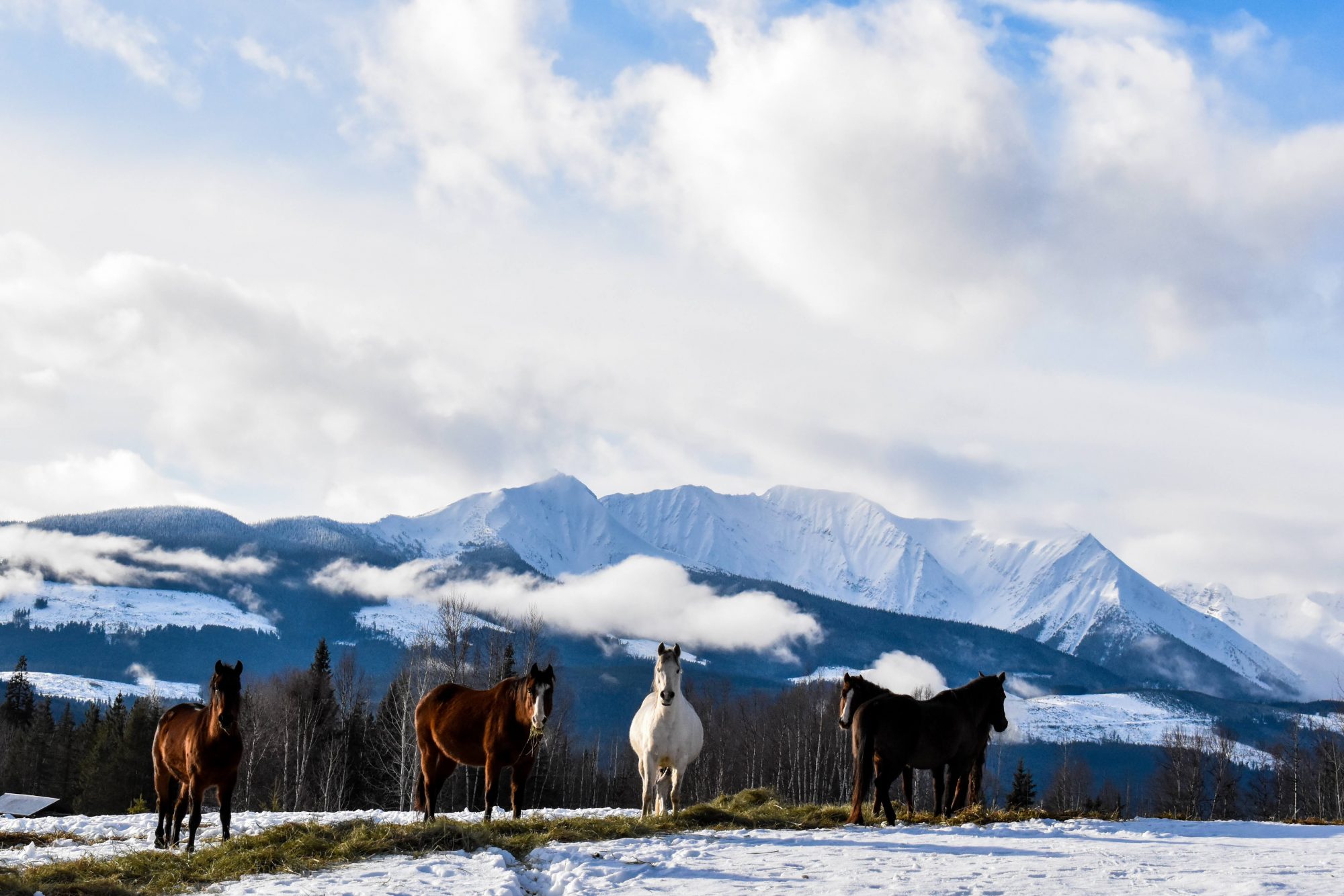

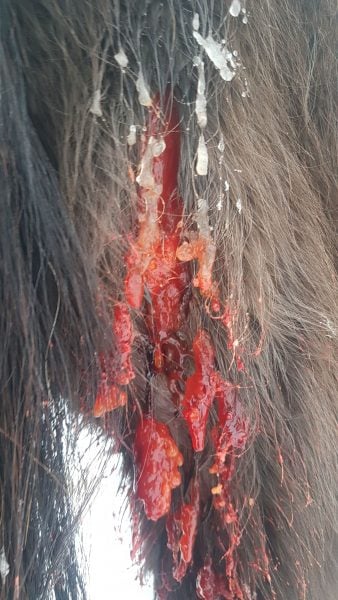
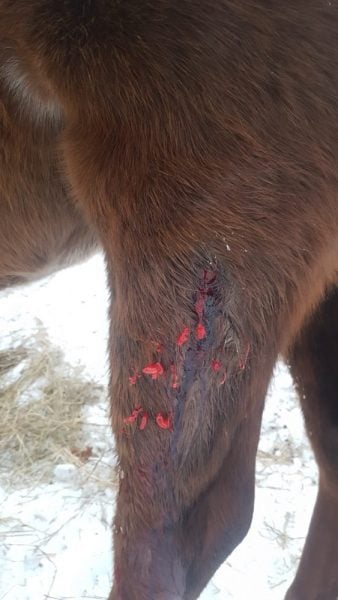



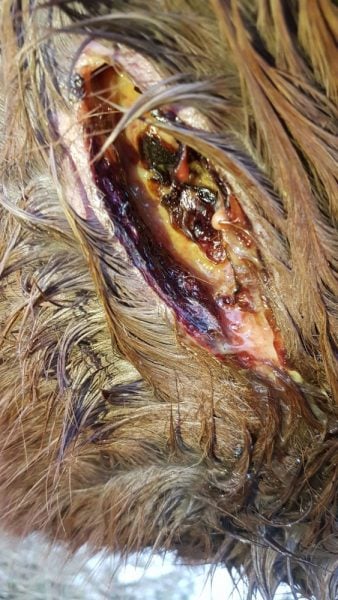

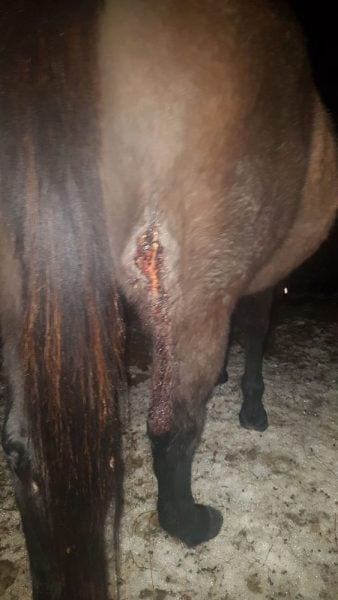

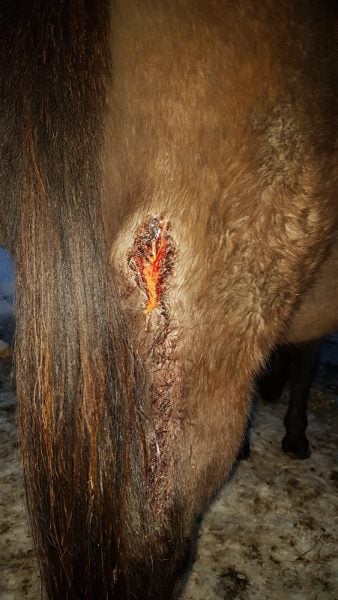


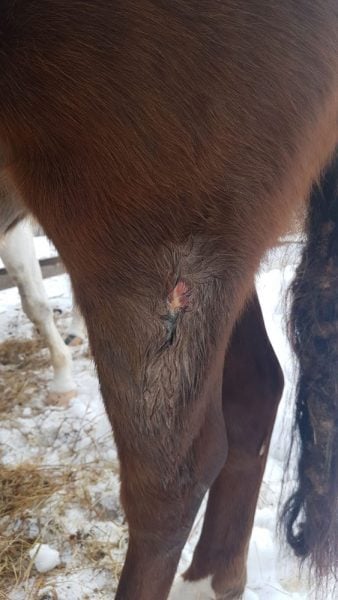
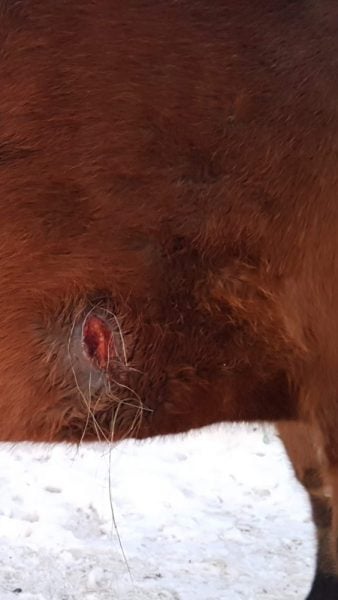

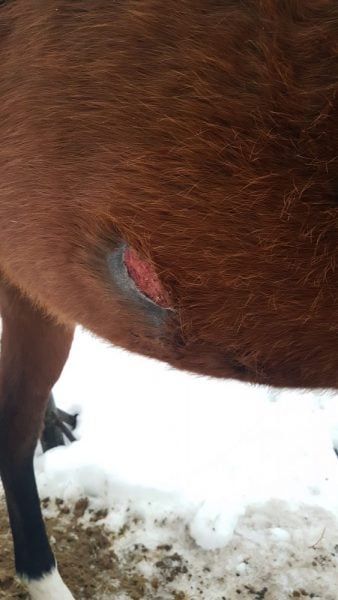

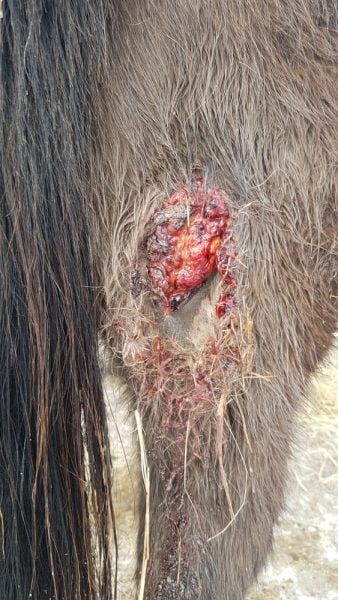



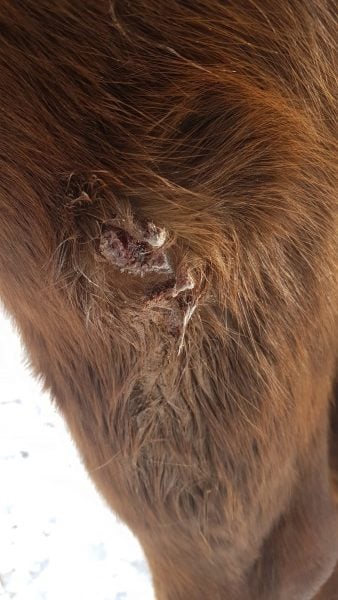







Oh, Kesia…thank you. as always, for sharing….
Wonderful, your documentation of this process of trusting observation and commentary on the self-healing within your stunningly beautiful herd. I’m envigorated; overjoyed!!! : )))))
It must be deeply satisfying to discover you succsessfully navigated through what was a worrying month. Like you, I appreciate Mary Walby’s wise words: Observation is also action..
Hats off to you!
xxxxxxx
How many wound-progress blog posts do you think are out there that elicit “overjoyed” as a response?! This just delights me. Because of course it’s about so much more than the wounds healing, and we all know that by now. Funnily enough, the navigation has mostly been about sitting on our hands and biting our tongues! And it’s true that documenting it and observing and discussing amongst ourselves without actually involving the horses took a lot of that “doing” energy and put it to good use – learning, and showing others. This community helped so much, even with the “permission” to take a passive role. Hats off to everyone!!!
Great story. We live in north central Florida with no shortage of vets, so I’m sure I would have freaked and intervened. I just read a review of a book by Christie Aschwanden entitled, Good to Go, that basically says much the same for human healing. Leave it be, the body sometimes knows best how to heal itself.
I do sometimes oddly appreciate our relative remoteness for this reason – it forces us to lean in and learn more, to trust the animals and to come closer into contact with the responsibility and inevitability tied up in caring for others. I don’t think there’s anything wrong with calling the vet when that’s a viable option, but I’m glad I get to learn that it’s not always necessary, even if that itself is kind of scary!
As Kesia’s farm partner I want to thank her for her incredible patience and courage through all of this. She MOST kindly left out the part where it was I who had let the pigs out to mingle and not thought to shut them in again when we left in a bit of a hurry that fateful day. I also wanted to add that for the first ten days I was terrified of tetanus. My niece in another part of the province had lost a lamb to tetanus after banding, and then two more after castration-by-vet, though these ones had been given injections. I had read that a combination of ledum and hypericum had been used by others to prevent tetanus but this is not an endorsement! Heck, I don’t KNOW! It’s quite possible there is no tetanus at our place, or that it wasn’t active in the cold. If animals are going to succumb to tetanus it is usually around Day 10 that you lose them. We did know, as Kesia said, that we were incredibly lucky that it was cold, with fresh clean snow, but days 5 and 6 (see above) were so scary. The weather had warmed to above zero and the barnyard wasn’t looking so pristine. Indeed, we were very active in observing (thank you Mary Walby for those words), and it takes energy and courage to sit on your hands and not intervene/interfere, but it was a hair-raising ride at times. I think this past while for me has been about learning to trust that the animals ARE communicating and will tell us what they need us to do. Often I know they are giving us a heads up to pay attention but that doesn’t always mean they want us to intervene.
When I had heard about the scenario, tetanus came to mind. Since it lives in the horse’s bowel, it is present in the environment in their manure. A puncture wound with no access to air that is contaminated with tetanus needs just three days to develop spores that would then start the disease process. By the time symptoms start to appear 10-14 days later, you just have to ride it out and hope for survival. I’ve wondered how extreme cold affects it sitting in the manure. Maybe since it’s frozen solid it stays in one place.
I was relieved by the gashes. As graphic as they were, they were not puncture wounds, and I knew they would heal without the threat of tetanus.
I can certainly appreciate how hair raising it can be for a month straight to be “monitoring” and listening to the horses. I can say from my own experience I have done the “monitor” right through to the death of a horse. Hands down, it was the most challenging thing I’ve ever experienced. The unknown is unknown, and yet we all know that everyone, horses included will die one day, and that part is not “unknown”. We just hope that the time is not now. Kesia, I like how you noticed that Falcon was injured, but not dying. Such a comforting thought to allow “monitoring”.
I’m so glad all the horses have healed and you’ve all come out on the other side. What a relief!
yes, sometimes an animal dies in our care or in our company. All of us die of course but it is some kind of art to figure out whether we are “supposed” to pull out all the stops and try to prolong life or whether we must reverently stand aside.
Yes, that is the ultimate question and definitely an art with no black and white answer.
Just an FYI: You can use wild oregano oil even on a puncture wound to kill tetanus. Just use a dental syringe (or needle if required) to inject it right into the tunnel. If it can kill MRSA and mycobacterium avium paratuberculosis – it can kill tetanus for sure!
https://www.medicalnewstoday.com/articles/130620.php
“We have done a few preliminary tests and have found that the essential oil from the oregano kills MRSA at a dilution 1 to 1,000.”
Thank you, Jini, for the oregano tip for tetanus. I will definitely add that to my toolkit.
Ah! Great to know. There’s always oregano oil in my cupboard.
Sharon, It reminds me that there have been a handful of times that I have been summoned by a horse to act. Three different horses, three different incidences. All of the times the horses indicated that there was a problem I was not aware of. It’s ironic how in my human mind I can think of all sorts of problems that I think need my help, but the horses have a different opinion, and then when there really is a problem, I don’t know it until they tell me. Knowing that they will summon me gives me courage to listen and observe when I’m not being summoned by them. I’ve now started taking note when I think something serious is happening, and they don’t think so. Like you said, sitting on my hands and letting it be all while still paying attention, that is the practice.
You’re right Mary, we do sometimes need those affirmations that there IS indeed communication happening – not just us thinking nothing is being required of us. When i think about times I have been asked to intervene… Spero has asked for a tummy rub to relieve colicky gas pain, Amalia has accepted minerals to help with a skin problem, and also let us help her rock her pregnant belly to help reposition her foal (Firefly). Falcon let my mom help him when he was cast against the fence, and they all let us know when they need basics – the water has run dry or it’s time for a new bale of hay. It’s really good to remind ourselves that they do indeed know how we can help them and how to ask us.
I sometimes make a point of showing the horses the various things I can offer or am willing to do for them, just so I know I tried… ultimately they keep telling me, keep us well fed with room to move and we can do almost everything else…
It’s funny how the whole point for me is that the horses in my care live in as natural of an environment as possible so all their innate horseness can be at its fullest expression. It’s a testament to that environment created for them in domestication where they can take care of themselves and don’t need much help other than food/water/shelter. So on one hand I feel good when I can help. On the other hand, I can also feel equally good that they don’t need my help today.
Yes! And what a fine thing to relax into, constant vigilance with a whole lot of nothing-doing 🙂
Wonderful story, Kesia! I’m so glad it worked out, and the horses once again let you know what they needed. It is no easy task for one month straight to monitor. Kudos to you! Have you recovered?
When horses started really challenging my idea of what they needed in their care, “neglect” is what came to mind. When I stopped and really looked at the situation, neglect would be turning a blind eye to what was happening. I realized that I was doing the exact opposite. I was so tuned in that I could let the animals “tell” me what they needed, if anything, and then I kept paying attention, looking for the slightest sign that I needed to intervene. Of course, that sign never came because they had it under control.
Even with the last horse I had who died at the end of Sept, the evening before she died I knew things were headed south, and I like to check the gums to see how far south we have headed. She was never a fan of letting me look at her gums. She let me do it once in 3 months. That evening she wouldn’t let me look at her gums. If she had, they may have shown that she was septic (which was confirmed the next day). Instead, all other vital signs were improving even though they weren’t great. It was enough for me to be able to sleep that night, and enough for her to have one last evening with her horse friends without human intervention. Even with death inevitable, horses still tell us what they want. So challenging, and so rewarding. If we can’t honor their voice, what do we really have? Congratulations!
I think once I saw how the wounds were progressing without infection, and the horses were moving normally, when Falcon’s swelling went away and especially when we crossed the tetanus-symptom timeline threshold… it’s been more a matter of documenting than of worrying too much. Again, that’s what checking in with other folks really helps with – permission to sit back. Also, when both vets told me they wouldn’t stitch those wounds to avoid contamination, that was a good confirmation that we were going to be okay. And living up here, everyone has stories of horses pulling through much worse injuries. So part of it, for me, is gauging where we are at on the danger spectrum.
My pup Orca who recently died of a mysterious bladder issue gave me a big workover on this whole concept of neglect vs attention, and honouring how, when, and even whether another being heals. She taught me the difference between tending to her (even petting or being with her) from a place of fear and trying to alleviate MY own anxiety, and from a genuine place of mutual connection. She also let me know she could die, to prepare me, but did it very stealthily when she chose to go, so that none of us was actually hovering over her or considering any heroics in the moment. She got to choose her place and time and I don’t begrudge her any of it. Like your sweetie, she wanted (and got) the dignity and choice that we so often take from our loved ones even when we are acting from what we think is love and care.
I think partly because there are SO MANY things we CAN do, or apply, or offer, we forget about the simplest and often most effective one – just being there. Thanks for all your eloquence on the subject – it’s a hard one to articulate and I’m glad we’re making inroads 🙂 If we are truly operating from love and trust rather than fear or denial, and we can convince ourselves it isn’t neglect of naivity, the whole experience shifts.
Kesia…your above comment really hit home. I lost both my dogs in the last few months. The first one was my soul mate dog. He loved me harder then I thought possible! I knew he was dying he had been diagnosed with liver cancer. I had him on powerful liver antioxidant pills and he made it a year after diagnosis. The day before he died I knew he wanted to go. I told my husband …but Gus Gus was still getting around and moiving pretty well so my husband said no he’s ok. That next morning I came out in the dark and he was almost dead. I panicked. Instead of enjoying those last few breaths we loaded him up for the 45 minute drive to the vet to have him put down as I couldn’t stand the thought of him in pain. He died on the way! I know I did a lot wrong but I also know he forgives me. Your words in this last comment gave me a lot of comfort. Animal death is so hard on our brains and hearts. Such a tight rope act of what’s right! This blog just continues to heal, help, and give me hope…to all the future has to offer and my ability to handle all that comes my way! ✌🏼❤️🐴🐶
Michelle, thank you for sharing the story of your dog and the moment of panic, and wishing you had “enjoyed those last few breaths” instead of trying to get to the vet. I have had the same thing happen to me. My panic area is way off to one side, so it doesn’t get touched much, if at all until something I consider dire happens, which thankfully is rare. Navigating the area of death and dying is tricky I think partly because it’s rarely talked about, so I don’t have any one else’s experience to help guide me along with my own. It is such a comfort to me to know that you would have preferred to enjoy those last moment with your dog as he was dying, and that was more important than anything else. Thank you for that little nugget.
I don’t know where to start! So much incredible stuff to chew on here. Just have to reiterate to Mary…observing is doing…such brilliant words to help soothe us through complicated situations! I think you have helped so many of us with these words!
Kesia…I really am impressed with your strength through this. I can only imagine how hard it is to follow and continue to listen to each of the horses as their wounds went through the stages of healing! Especially when all the swelling and Amalias proud flesh sets in…that part seems like it would be extra hard wondering if allowing the body to heal at its own pace is the right thing to do? You might not of felt strong but you really were! Listening seems to be so hard for me at times? Even when it’s so clear and I want to listen! I know these Examples are far from an injury situation like yours but they were super profound communications that have hit so strongly lately for me. We were trimming 2 of the horses hooves last week and since I have been getting it right…less is more…(which is what my husband always wanted.. I have been through so many stages with trimming 😩 ) Bullet has been like a rock. Before when I was over trimming he was moving all around …yelling at me in his own way! So now that I am getting it right it’s so incredible how he just stands so still! Except when I suggested taking a little off his frog…my husband said no I said yes and Bullet violently stomped his hoof down…doesn’t get much clearer then that…I said ok your right I am wrong we won’t touch it! Another example is the trailer. When I first brought Dreamer home he had absolutely no issues with getting in the trailer but as time has gone on ( I think he now knows I am capable of listening) I noticed we were having issues with it ? But these words popped into my head that I know now he gave me ….it was that he just needed to practice backing out! Hes fine to load & turn around but as athletic as he is he cannot mentally/physically step backwards out of the trailer and this frustrates and scares him! So now when we do our practicing that’s what we focus on! We take it at his pace and he practices lifting up his back leg and tapping it or resting it on the trailer! We also will sometimes practice on a huge cement platform I have and practice backing off of that a couple of times so that he can practice it without the stress of the trailer..! The amazing thing is each time we do go somewhere he gets right in the trailer now ….because that is the words that he said to me ….if you just help me learn how to back out of the trailer…. each time we go somewhere I will just get right in and he has held true to that every time! It’s been absolutely remarkable to me and such a clear perfect example of listening to the horse!! I thought I was making it all up but it has rang as true as could be! Our new family member Buck has also asked me to help him get comfortable with turning around in the trailer he’s not afraid to load or to back out but he can’t turn to his right comfortably/confidently it’s just amazing that when you listen how smoothly and easily it can go. Even if it doesn’t feel that way in our heads! I feel a lot of the time when they don’t comply with my requests I want to jump to the conclusion they are going against me…but where my mind needs to be …is listening to the why? And then probably more importantly respecting that and moving on from there! ✌🏼❤️🐴
I love that your husband is getting so involved – how cool is that? And looks like he has pretty great listening skills too 🙂
And SO wonderful to hear how you are now able to hear everyone so clearly. It turns the concept of “training” even further on it’s head, doesn’t it? Instead of having an agenda of what we want to teach them, asking them, “What do you want to learn, practice, or need my help/support with?” It’s so much more fun too!
We brought Montaro and Zorra in from doing ‘trailer play’ about a month ago. Who knew getting in and out on the ROAD would be 5 more big challenges to them?? We thought, “Oh they’re going in and out no problem, let’s take them to a park.” But the ROAD changed everything. Duh. Anyway, so we just played around with getting in and out and the herd could watch from the front pasture – which they did. When we brought Taro and Zo back, little Posa walked right up to me and asked to learn how to wear the halter/leading so that she could have adventures too. Bless. So we did 5 minutes of ‘halter training’ right there. In 5 minutes she had the rope wrapped ‘halter style’ around her face and then also learned to pair my hand/voice signals with rope pressure on her neck as she followed me around the paddock, turned left, turned right. Then Xadaa asked for a turn. MY plan was to not touch them for a couple years at least LOL.
Sorry Michelle and Jini, I missed these comments!
Michelle I love the depth of listening that you’re noticing and running with. It’s all so cool, because at the same time we’re exercising our listening skills and if and when we face a crisis we can trust more in what we hear. And in the meantime it’s fun and interesting!
Isn’t it cool how the more you pause to listen, the more exciting all these little things get? Like before, you’re thinking “I need to get this horse on this trailer” and that and only that will make you feel like you succeeded. Whereas when the dialogue gets to develop, there is so much nuance and discovery that “getting to the point” is no longer the point and the horse and the human both get way more out of the process, and sometimes the original idea gets forgotten or thrown away or changed!
And Jini – little sweeties!! I love it – it’s their idea in the truest sense, and you get to go along for the ride!
Faaaaascinating! How they dealt with the proud flesh makes perfect sense. Thanks for sharing.
Right?! Mind-bogglingly obvious, but not until we were paying attention…
“the more I listen, the less I do” … this has been my own experience with my herd more and more. Thank you for putting it into such profound yet simple words. I do believe, from my perspective with my herd, that’s really what they want from us. I have struggled internally with having a herd that doesn’t necessarily meet the “expectations” of what a well maintained domestic horse should look like… but reading this post from you confirms something that I have known deep down for awhile. They know what they need. And want. It’s up to us to be willing to give them a choice, a voice and listen and honour them. That’s when the real life learning comes ❤️
Isn’t it wild when we start looking at our truest motives? Is this for my horse, or is this secretly for me? The more we can pare it down, I think, the better. But yes, haha, our herds may look a little more raggedy around the edges like their wilder counterparts…